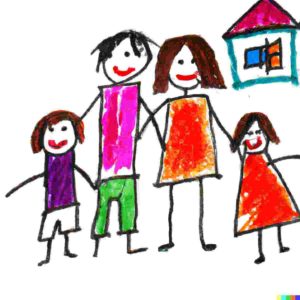ESL/EFL Level: Upper-intermediate (B2/C1)
Lesson Topic: Changes in family structures and marriage as an institution
Skill Focus: Speaking, Reading, Vocabulary
Approximate Class Time: 1.5 hours
Lesson Plan Download: family-lesson-plan-upper-intermediate-022023.docx
Lesson Overview:
Lesson Topic: Changes in family structures and marriage as an institution
Skill Focus: Speaking, Reading, Vocabulary
Approximate Class Time: 1.5 hours
Lesson Plan Download: family-lesson-plan-upper-intermediate-022023.docx
Lesson Overview:
- The reading passage discusses changes in the traditional (nuclear) family structure, summarizes some social trends related to marriage and childbirth in the U.S. and globally, and mentions some reproductive technology.
- The lesson also includes a focus on the names of different relatives, a list of family-related scenarios for discussion, two role-plays, a debate on arranged marriage, and a 'family meeting' speaking activity.
- All lessons come with warm-up questions, comprehension questions, a vocabulary section, and discussion questions.

UPPER-INTERMEDIATE (B2/C1) Family ESL Lesson Plan
Warm-up (Pair Work)
- What is the best environment to raise a family in (e.g. apartment, village, etc)?
- What was the worst thing you did as a child? Did you get caught?
- Is there anything funny or different about your family?
- Does someone in your family maintain a family tree? How far back can you trace your family history?
Membership is required to view this post. Please support EnglishCurrent by becoming a member today. Members, please log in.
-- EFL Lesson plan on the family written by Matthew Barton of EnglishCurrent.com (copyright). Site members may photocopy and edit the file for their classes. Permission is not given to rebrand the lesson, redistribute it on another platform, or sell it as part of commercial course curriculum. For questions, contact the author.
Follow-up question answers
- A nuclear family is a family with a father, mother, and children.
- The conflict is between data that suggests marriage for love reduces the likelihood of divorce and data from India showing that non-love marriages have very low divorce rates.
- …
- A boomerang child is one who returns home to live with his parents in adulthood.
- The low fertility rate is related.
- …
- …
- …
Vocabulary answers: 1-j, 2-b, 3-I, 4-d, 5-a, 6-e, 7-f, 8-h, 9-k, 10-g, 11-c
Page 2 answers: niece, nephew, great-grandmother, siblings, brother-in-law, stepbrother
End notes:
- [1] http://en.wikipedia.org/wiki/Family
- [2] https://www.telegraph.co.uk/news/2022/10/30/couples-who-marry-family-pressure-50-per-cent-likely-divorce/
- [3] https://www.brides.com/story/modern-arranged-marriages
- [4] https://www.childtrends.org/publications/dramatic-increase-in-percentage-of-births-outside-marriage-among-whites-hispanics-and-women-with-higher-education-levels
- [5] https://www.psychologytoday.com/ca/blog/hide-and-seek/201708/what-future-the-family
- [6] https://www.un.org/development/desa/family/wp-content/uploads/sites/23/2020/06/Mega-trends-and-families.Trask_.pdf
- [7] https://www.theguardian.com/lifeandstyle/2019/dec/31/family-2050-artificial-wombs-robot-carers-single-fathers

Great ideas! Thank you!
Lots of ideas. Just great
Lots of ideas. Just great
So complete, Great Ideas and exercices. thanks
Fantastic! Complete and thorough, simply perfectly done!
Amazing ideas! Thanks!
Thanks a bunch for this amazing lesson!
Great to learn vocabulary, I found it an in-depth lesson. Fantastic discussions which forced me to use a wide variety of vocabulary.
No hay respuestas
Pingback: Families and Personality | English for Advanced level at E.O.I.
i really liked questions for discussion.very interesting and make people think deeply about all of them